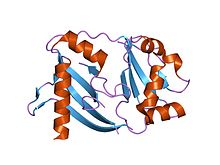CRISPR-Cas
| Cascade (CRISPR-associated complex for antiviral defense) |

Structure of crRNA-guided E. coli Cascade complex (Cas, blue) bound to single-stranded DNA (orange).
|
| Identifiers |
| Organism |
Escherichia coli |
| Symbol |
? |
| PDB |
4QYZ |
CRISPR () is a family of DNA sequences in bacteria. The sequences contain snippets of DNA from viruses that have attacked the bacterium. These snippets are used by the bacterium to detect and destroy DNA from similar viruses during subsequent attacks. These sequences play a key role in a bacterial defence system, and form the basis of a technology known as CRISPR/Cas9 that effectively and specifically changes genes within organisms.
The CRISPR/Cas system is a prokaryotic immune system that confers resistance to foreign genetic elements such as those present within plasmids and phages that provides a form of acquired immunity. RNA harboring the spacer sequence helps Cas (CRISPR-associated) proteins recognize and cut exogenous DNA. Other RNA-guided Cas proteins cut foreign RNA. CRISPRs are found in approximately 40% of sequenced bacterial genomes and 90% of sequenced archaea.
CRISPR is an abbreviation of Clustered Regularly Interspaced Short Palindromic Repeats. The name was minted at a time when the origin and use of the interspacing subsequences were not known. At that time the CRISPRs were described as segments of prokaryotic DNA containing short, repetitive base sequences. In a palindromic repeat, the sequence of nucleotides is the same in both directions. Each repetition is followed by short segments of spacer DNA from previous exposures to foreign DNA (e.g., a virus or plasmid). Small clusters of cas (CRISPR-associated system) genes are located next to CRISPR sequences.
...
Wikipedia



